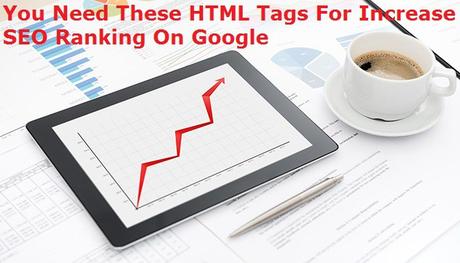Every marketing professional knows how important SEO is in the age of digital technology and Increase SEO Ranking On Google. But if you’re on a marketing team with beginner to intermediate knowledge of SEO, what do you need to know to launch your first successful SEO campaign?
HTML is the underlying code used to create web pages. Search engines can pick up ranking signals from specific HTML elements.
If you look at the source code of any web page, you’ll see that all web page has some HTML tags and these tags are important for Increase Seo Ranking On Google. It’s simply the code that web browsers “read” to figure out how to display a webpage’s contents.
Google and other search engines read your source code to find out what your site is about. Below are some of the most important HTML elements to achieve SEO success.

So let’s See these HTML Tags For Increase SEO Ranking On Google.
1. Title Tag
This is arguably the most important tag that you need to be familiar with when it comes to increasing your website rankings. For any search engine to rank your website, it needs to know what your content is about, what each page is about, and what your site as a whole is about.
The title tag describes the topic of each page or piece of content on your website. And it does it in a way that search engines can understand. You want to make sure you only have one title tag per page. What you put in the title tag is basically how Google decides what’s going to be in search engine results.
Also Read: Best SEO Techniques for Healthy Link Building of Your Website
2. Meta Description Tag
Right after the title tag, the Meta Description Tag is an absolute must for anyone who is serious about their SEO.
SEO purists will argue that the meta description tag isn’t a “ranking factor” and that it doesn’t actually help your pages rank higher. Rather, it’s a “display factor,” something that helps how you look if you appear in the top results due to other factors.
Each web page should have one target keyword. And that keyword should show itself in the title tag and meta description.
3. Heading Tags
There are several different header tags. Depending on your format, you might have h1, h2, h3, and sometimes h4 or even h5. H1 Heading is the main heading on a page.
Header tags are a formal way to identify key sections of a web page. Search engines have long used them as clues to what a page is about.
If the words you want to be found for are in header tags, you have a slightly increased chance of appearing in searches for those words.
4. Image Alt Tag
Alt tags are an SEO opportunity that many people miss. The Image Alt tag is another tag that is extremely important HTML Tag For Increase SEO Ranking On Google.
And why you need to add Image Alt Tag in your web pages Because Search engines can’t read images, but search engines can read words.
This means that to have a chance for your images to rank on Google, you need to include alt tags on all of your screenshots and photos.
Read: HOW TO INCREASE INSTAGRAM FOLLOWERS
5. Internal Links and Anchor Text
An important basic is how internal links and Anchor Tag Texts work. On any web page, you’ll have links to any content.
Whenever you want to include stats or images from different sources, you need to make sure that you’re giving credit where credit is due.
Most people will just add the link and forget about the anchor text, which is unfortunate for SEO endeavors.
If you’re linking to someone else’s website and you provide a good anchor tag, it will help their rankings more than the link alone. And if you’re linking to a page on your own website, it will help your own domain authority because it keeps your content organized.
6. Nofollow Links
There are a few reasons you need to know about nofollow link tags. Nofollow tags tell search engines not to lend credence to the backlink that you’re creating for the website.
You might want to consider using nofollow links on your own website when you link to a website with poor domain authority.
The “Nofollow” attribute tells Google and other search engines not to follow the link to the next page and not count it as link juice. You’re hugging up your page with no follows if you use them.
7. Canonical tags
The canonical tag is great for organizing your content and prioritizing one web page over a duplicate web page.
It’s important because if you have a lot of web pages that have similar content, you can tell Google that the only page they should page attention to is a certain page and this is a good way to stop duplicate content on a webpage.
HTML Tags For Increase SEO Ranking
You May Also Like:-
5 Ways to Reduce Abandoned Carts with Marketing Automation
On-Page SEO Techniques to Rank on the First Page
How To Use WordPress Guide For Beginners
